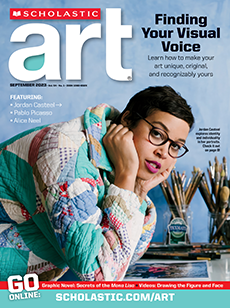Jacob Lawrence (1917-2000) was an African American painter who developed a figurative style marked by flat forms and bold and direct colors. Most of his works depicted black life, history, and culture. They also illustrated notably significant events or personages in a narrative serial format. These multiple images—usually tempera, casein, or gouache on paper or hardboard—were often accompanied by text researched by the artist.
Jacob Armstead Lawrence was born in Atlantic City, N.J., on Sept. 7, 1917. His family lived in Easton, PA., and in Philadelphia before moving in 1926 to Harlem, in New York City, whose museums and art centers provided Lawrence with his first exposure to art. In 1932 he began studying with the leading black artist Charles Alston at the Harlem Art Workshop. Lawrence won a two-year scholarship to the American Artists School in 1937, the year he first exhibited and began his first series, Toussaint L'Ouverture (1937-1938; Amistad Research Center, New Orleans).
In 1938 Lawrence had his first one-man show at the Harlem YMCA. Soon after came the Frederick Douglass (1938-1939) and Harriet Tubman (1939-1940) series (both, Hampton University Museum, Va.). He won second prize for Toussaint L'Ouverture at the American Negro Exposition in Chicago in 1940. That year he started his most celebrated work, the Migration of the Negro (1940-1941; various collections), comprising 60 paintings that chronicle the exodus of southern blacks to the urban North after World War I. Then followed the John Brown (1941; Detroit Institute of Arts) and Harlem (1942-1943; various collections) series, the latter a highly personal sequence of 30 genre scenes created from childhood recollections and impressions.
Lawrence joined the U.S. Coast Guard in 1943, and the next year the Museum of Modern Art circulated a major exhibition of his works. The War series (1946-1947; Whitney Museum of American Art, New York City) was begun after he ended his tour of duty. The themes of subsequent series included hospitals, theater, builders, Nigeria, and Hiroshima. He also painted single works, whose subjects ranged from pool parlors, street scenes, and the Serengeti Plain to musicians, self-portraits, and an image of Jesse Jackson that became the cover of Time magazine in 1970. In addition, Lawrence designed or produced silkscreen prints, serigraphs, posters, and large-scale murals, such as Games (1979; formerly in Seattle's Kingdome Stadium, which was destroyed in a controlled explosion in 2000, and then transferred to the Washington State Convention and Trade Center, Seattle), a ten-panel, porcelain-enamel-on-steel work depicting athletes and their fans.
Throughout his long career Lawrence received many fellowships and awards (including the National Association for the Advancement of Colored People's Spingarn Medal in 1970) as well as over a dozen honorary doctoral degrees. His work is in scores of public and private collections worldwide. He taught art at Black Mountain College, Skowhegan School of Painting and Sculpture, and the University of Washington in Seattle, among other places. Lawrence died on June 9, 2000, at his home in Seattle.
Lawrence's contribution to American modernism was to establish the narrative figurative tradition in a contemporary context at a time when this style and content were decidedly out of fashion. These works distinguish Lawrence as a major U.S. painter who opened new avenues of opportunities for future artists. He held certain basic principles regarding painting; thoughts, feelings, and experience balanced with universality, clarity, and strength were the essence of his creativity. Lawrence painted the life and culture he knew best, its struggles and its strengths, its past and its present; and he helped to create a definitive aesthetic vision critical to the American art scene.
